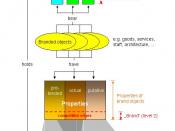Abstract
Brand extensions allow companies to leverage the equity they have established into new product and market areas, reducing the costs and risks associated with the fearful task of launching a new brand in today's viscous markets. However, brand extension is a two-sided blade, and miscommunication between consumers and brand managers can easily lead to image confusion and, ultimately, failure.
This paper investigates the importance of a clear understanding on consumer perception of a company's brand identity when evaluating possible brand extension. Through the analysis of three different corporate examples of extensions (McDonald's, Harley Davidson, Heinz) we explore the detriments of failed brand image transfers. All three companies discussed tried to extend their brand in a direction that did not fit with their brand identity, therefore failing to understand their perceived brand identity and unsuccessfully trying to extend their brand.
Table of Contents
1 Introduction...........1
1.1 Background.........1
1.2 Problem..............1
1.3 Purpose 2
1.4 Method 2
2 Theoretical Framework 3
2.1 Brand Identity 3
2.2 Brand Loyalty 3
2.3 Brand Image 3
2.4 Brand Awareness 3
2.5 Brand Equity 4
2.6 Valuing Brand Equity 4
2.7 Brand-added Value 5
2.8 Brand Extension 5
3 Empirical Findings 9
3.1 Mc Donald's 9
3.2 Harley Davidson 12
3.3 Heinz 13
4 Analysis 15
4.1 Mc Donald's 15
4.2 Harley Davidson 16
4.3 Heinz 16
5 Conclusion 17
1 Introduction
1.1 Background
The high degree of International interest in branding is a relatively recent phenomenon. During the 1980's, there was a wave of takeovers, acquisitions and mergers by companies trying to unite business operations--both similar and unrelated--under one strong brand name. As a resultant price-to-earnings ratios skyrocketed, and brand extension strategy was viewed as the new pathway to industry success and market domination (Kapferer, 1997).
According to Kotler, Wong & Saunders (2005),


